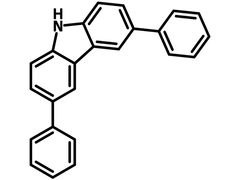3,6-Diphenylcarbazole
CAS Number 56525-79-2
Chemistry Building Blocks, Heterocyclic Building Blocks, Materials, MonomersA carbazole derivative as electron donating intermediate
For construction of more complex structures of small semiconducting materials as host and active materials for highly efficient light-emitting electrochemical cells, thermally activated delayed fluorescent OLED devices.
Specifications | MSDS | Literature and Reviews
3,6-Diphenylcarbazole (DPhCz) is another electron-donating 9H-carbazole derivative with extended π-π conjugation from carbazole fused rings to the phenyl groups attached at 3,-6 positions. The degree of electron donating strength is in the order of carbazole 3,6-dimethylcarbazole 3,6-diphenylcarbazole, resulting in the relatively red-shift of emissions of 3,6-dimethylcarbazole and 3,6-diphenylcarbazole while comparing non-substituted carbazoles.
3Ph2CzCzBN, a highly efficient sky-blue emitter, derived from benzonitrile with four 3,6-diphenylcarbazole pendants around the benzene ring, shows a electroluminescence of 482 nm and achieves Commission Internationale de l’ Eclairage coordinates of (0.17, 0.36). Device based on the fluorescence emitter 3Ph2CzCzBN exhibits a high external quantum efficiency of 16.6% at 1000 cd m-2 with a great LT90 of 38 h.
Diphenylcarbazole building block
for the synthesis of OLED and organic photovoltaic materials
Worldwide shipping
Quick and reliable shipping
With extended π-π conjugation
Resulting in red-shift emission
High purity
>98% Purity
General Information
| CAS Number | 56525-79-2 |
| Chemical Formula | C24H17N |
| Full Name | 3,6-Diphenylcarbazole |
| Molecular Weight | 319.41 g/mol |
| Synonyms | 3,6-Diphenyl-9H-carbazole, DPhCz |
| Classification / Family | Carbazoles, semiconductor synthesis intermediates, Electron donor unit, OLED, OFETs, organic photovoltaics |
Chemical Structure
Product Details
| Purity | >98% (1H NMR) |
| Melting Point | 184 °C |
| Appearance | White to off-white powder/crystals |
MSDS Documentation
 3,6-Diphenylcarbazole MSDS Sheet
3,6-Diphenylcarbazole MSDS Sheet
Literature and Reviews
-
High-efficiency, long-lifetime deep-blue organic light-emitting diodes, S. Jeon et al., Nat. Photonics, 15, 208–215 (2021); DOI: 10.1038/s41566-021-00763-5.
-
Intrinsically Ionic, Thermally Activated Delayed Fluorescent Materials for Efficient, Bright, and Stable Light-Emitting Electrochemical Cells, R. Yu et al., Adv. Funct. Mater., 32 (13), 2110623 (2022); DOI: 10.1002/adfm.202110623.
-
Effect of Carrier Balance on Device Degradation of Organic Light-Emitting Diodes Based on Thermally Activated Delayed Fluorescence Emitters, M. Tanaka et al., Adv. Electron. Mater., 5 (5), 1800708 (2019); DOI: 10.1002/aelm.201800708.

